Translate this page into:
Bibliometric analysis, progress and prospects of Journal of King Saud University-Science at global level
⁎Corresponding author at: Department of Physiology, College of Medicine, King Saud University, PO Box 2925, Riyadh 11461, Saudi Arabia. smeo@ksu.edu.sa (Sultan Ayoub Meo),
-
Received: ,
Accepted: ,
This article was originally published by Elsevier and was migrated to Scientific Scholar after the change of Publisher.
Peer review under responsibility of King Saud University.
Abstract
Objective
This study aimed to investigate the bibliometric analysis, progress and prospects of the journal of King Saud University-Science (JKSU-Science) in global sciences.
Material and methods
In this study, we recorded the number of research documents, number of citations, citations per document, impact factor and Hirsch index (h-Index) of JKSU-Science from January 2016 to December 2020. The main source of information was Clarivate Analytics Web of Science, Elsevier Science Direct and SCI-mago/Scopus.
Results
The JKSU-Science contributed 910 articles, 3373 citations, 3.75 citations per document, with an impact factor of 3.819 and Hirsch (h-index) of 20. The journal provides an opportunity for the global science community to contribute their research work and promote research at global levels.
Conclusions
The performance of JKSU-Science in global sciences has markedly increased during the period 2016–2020. The global contribution, research publications, impact factor, citations, and h-Index are continuously on a mounting path. The journal is playing a pivotal role in enhancing the research culture and country research ranking both at regional as well as international levels.
Keywords
JKSU-Science
Progress
Prospects
Global ranking
1 Introduction
In the middle ages, the Arab and the Islamic civilization were the center of attention in many fields especially in science and medicine. The Arab states, mainly the Gulf Cooperation Council (GCC) countries are considered as developed nations with strong economical foundations (Benamer and Bakoush, 2009). In the recent years, Saudi Arabia took a position in academics and research. The “Vision 2030” program aims to promote research activities and innovation in the country (Shamsan and Al Mutair, 2019).
Saudi Arabia is the largest country of the Arabian Peninsula with a population of about 34.21 million people (General Authority for Statistics, Saudi Arabia, 2020). The state has economic advantages and is immensely blessed with natural resources (Meo et al., 2013a). The KSA is moving forward to promote quality education, and research culture in the country (Meo et al., 2013b). Research in science and social sciences is a precious tool for institutional development, economic growth, long-term sustainable development, and to enhance the living standard and quality of life (Macilwain, 2010). The research indicators are mainly based on the universities, academic institutes and scientific journals (Meo et al., 2013b).
The scientific journals and their publications play a key role in the dissemination of knowledge and the development of nations. There is an association between research and the overall development of individual states and their economies. The basic birthplace for research and innovation are the universities and their scientific journals. The scientific journals publicize the information, and promote research development and discoveries (Meo and Eldawlatly, 2018).
The scholarly journals have been in existence for over 350 years and have had an impact on scientific advancement, scholarly credits, exchange of knowledge, in validating the quality of research, and in the building of the scientific nation (Meo and Eldawlatly, 2018). Considering the role of academic journals, Saudi Arabia has established a number of journals in various universities. King Saud University, one of the leading universities of the Muslim world introduced a few journals including the Journal of King Saud University-Science which was established in 2009. In a short period of time, the journal become very popular in the science community. The present study aimed to investigate the research outcome of the journal of King Saud University-Science (JKSU-Science) from January 2016 to December 2020.
2 Material and methods
This observational study was conducted in the “Department of Physiology, College of Medicine, King Saud University, Riyadh, Saudi Arabia”. The present study investigated the research publications, citations, impact factor, Hirsch index (h-Index) of JKSU-Science. We recorded the number of research documents, number of citations, citations per document, impact factor and h-Index of the JKSU-Science during the period Jan 2016 to Dec 2020. The main source for information was recorded from the “Clarivate Analytics Web of Science (2020), JKSU-Science, Elsevier (2021) and Scimago journal and country ranking (2021).”
We logged on to “Clarivate Analytics Web of Science” the territory was selected, country name “Saudi Arabia” was entered, and the names of journals “Journal of King Saud University-Science” along with required information for the journal was retrieved. A comprehensive information about “bibliometric indicators including a total number of research papers (documents), citable documents, total citations, citations per document and Hirsch Index (h-index)” in various disciplines were obtained.
2.1 Statistical analysis and ethical approval
The required information was recorded and analyzed. Graphs were prepared using Microsoft PowerBI. Mantel-Haenszel Chi-square was applied to observe associations between qualitative variables using IBM SPSS 26. A p-value of less than 0.05 was considered as statistically significant. The data were obtained from publicly available websites including “Clarivate Analytics Web of Science”, “SCI-mago/Scopus” and “Elsevier Science Direct”. As the data were publicly available, hence we did not obtain the ethical approval.
3 Results
The data in Fig. 1 shows the rate of submission, acceptance and rejection of manuscripts from the year 2016–2020 depicts an upward trend in comparison to the year 2019 the percentage decrease in submission and rejection was observed to be 39.73% and 34.41% respectively. The acceptance of manuscripts from 2016 to 2020 showed a continuously increasing trend, nevertheless, for the year 2020, results showed an increase of 38.86% in comparison to the year 2019 (Fig. 1). Number of manuscripts that were withdrawn / removed reached the maximum in the year 2019, however, this number significantly decreased by 46.43% in the year 2020 (Fig. 1). A year-wise increase was again observed in terms of number of published articles from 2016 to 2020, where the peak was observed in the year 2020 with 505 publications. The standard rejection rate also significantly increased when compared from 2016 to 2020, it reached to the maximum in the year 2020 (Fig. 1).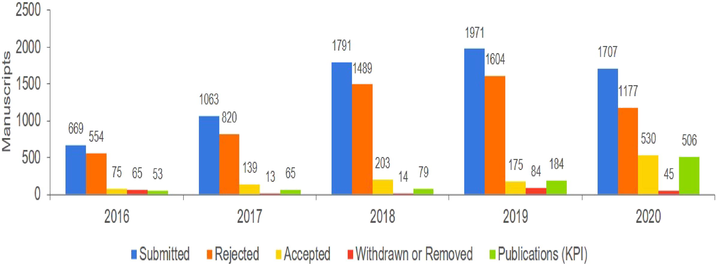
The rate of articles submission, acceptance, and rejection in the JKSU-Science.
The Fig. 2 shows the rate of submission of articles in the JKSU-Science during the period 2016–2020. The maximum number of articles were submitted from the Kingdom of Saudi Arabia, India, China, Pakistan, Egypt, Nigeria, Malaysia, Morocco, Algerai, and South Africa. The results also show that from the year 2016–2020, the journal received most of the articles from the Asia region, followed by the Africa region, European region and South America region. However, the journal received manuscripts from North and Central America and Oceania.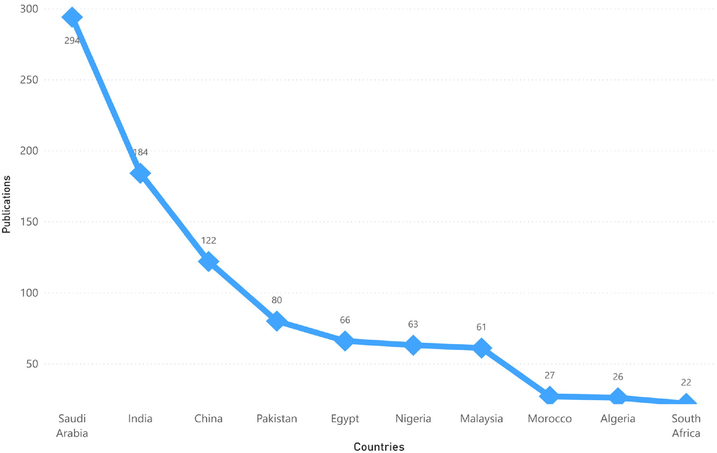
Global submission of articles in JKSU-Science during the year 2016–2020.
Fig. 3 demonstrates the Impact Factor (IF) of various journals of Kingdom of Saudi Arabia during the year 2019. There is a total of 15 journals, which are indexed in the “Clarivate Analytics Web of Science”. The JKSU-Science achieved a second highest ranking in achieving Impact Factor of 3.819 however, the Arabian journal of chemistry achieved IF 4.762 (Fig. 3).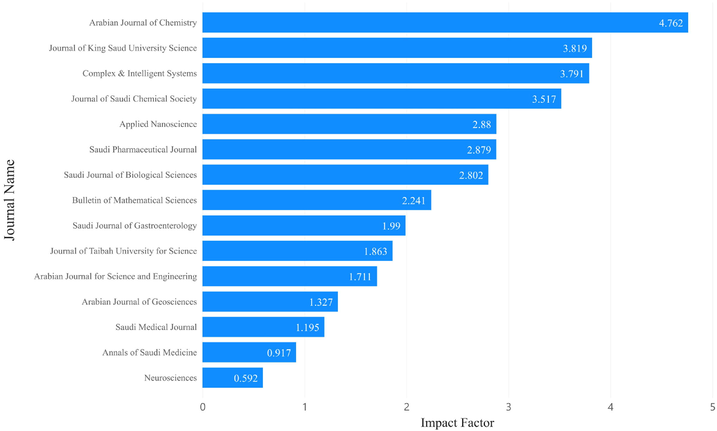
Impact Factor of various journals of Kingdom of Saudi Arabia during the year 2019.
The journal received an IF of 2.835 in the year 2018 that increased to 3.819 in the year 2010, parallelly, a continuously increasing trend was observed in the year-wise number of citations, from 8 in 2015 to 1786 in 2020 (Fig. 4). Number of articles published in the year 2018 = 76; Number of articles published in the year 2019 = 204; Number of citations in the year 2020 = 1786 (Fig. 4). The number of articles, Impact factor and global visibility (citation) of the articles published in the JKSU-Science are continuously increasing (Fig. 4).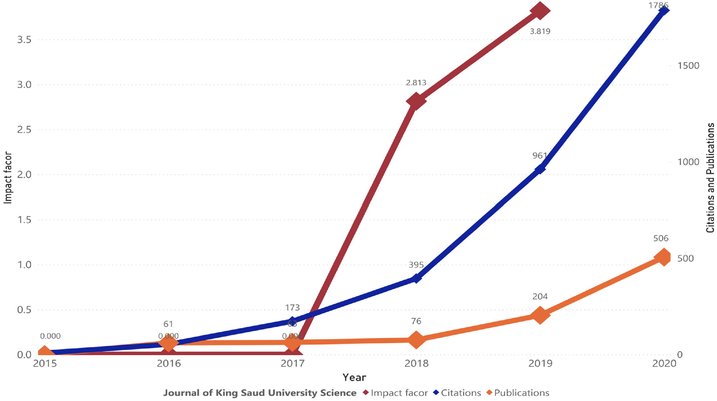
Number of Publications, Impact Factor, and Citations of JKSU-Science during the period 2015–2020.
The result of Mantel-Haenszel chi-square showed that the number of weeks from submission to first decision significantly reduced by 12.33% when compared between 2016 and 2020 (p < 0.001). The time from submission to acceptance had a mixed pattern, however, in comparison to 2019 the number of weeks significantly reduced by 12.92% in the year 2020 but the association was not significant (p = 0.437). Similarly, the number of weeks from submission to first online again significantly decreased by 9.35% in the year 2020 when compared with 2019 (p = 0.002). However, this number was minimum in the year 2017 with an average of 15.2 weeks. The average time from submission to publication and submission to final publication significantly improved in the year 2020 in comparison to 2016–2019 (p < 0.001). In comparison to 2019, the number of weeks for submission to publication and submission to final publication significantly reduced by 46.48% respectively (p < 0.001) Fig. 5.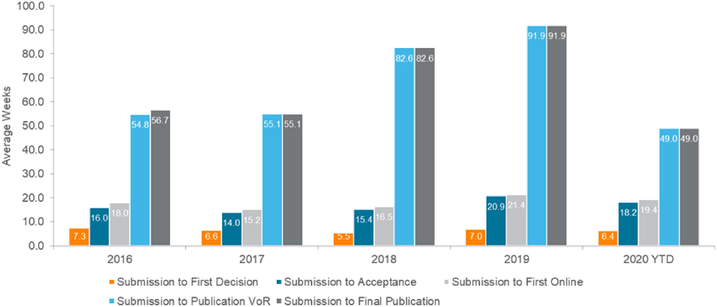
Average editorial and publication time period for published article.
4 Discussion
Saudi Arabia is the largest country in the Arabian Peninsula, sanctified with noteworthy natural resources, including oil, gas and minerals. Saudi Arabia has recognized the significance of higher education, science and technology and the importance of research. The state has established many universities, research and advanced technical institutes in the far-flung areas of the country (Meo, 2015). There are about 75 universities and degree-awarding institutes. In 2020 alone, Saudi Arabia produced a total of 251,094 research documents and 35,083 research papers in the database “Clarivate Analytics Web of Science”. Moreover, Saudi Arabia achieved the 41st position in global ranking in science with country’s Hirsch Index (h-index) being 361 (Scimago, 2020).
The rising research position of Saudi Arabia and research visibility in global science is due to the undergraduate, graduate students and faculty expressing their interest in research projects (Alamri et al., 2020). Moreover, medical students showed a positive attitude towards research activities (Alsayegh et al., 2020). It has also been reported that in Saudi Arabia research is on the rising path; well-established institutions such as King Saud University have taken the lead in publishing research, and international collaboration in various subfields (Alhibshi et al., 2002).
Meo (2015) reported that Saudi Arabia is turning into a hub for advanced education, research, science and technology and swiftly shifting from an oil-based to a knowledge-based economy. Many universities and research institutes have established several academic journals and these journals achieved a position in global science. Lei and Xu (2020) reported that the total publications of Journal of King Saud University-Science (JKSU-S) increased, while the total citations and h-index presented an upward trend. However, in the present study we found a continuously rising trend in the number of articles, impact factor, and citation during the period 2016 to 2020.
In the Kingdom of Saudi Arabia there are 15 scientific journals which are indexed in a Journal Citation Report, Clarivate Analytics, Web of Science. The JKSU-Science achieved the second highest standing with an impact factor of 3.81 (Fig. 2) which shows the ranking in global science. The JKSU-Science is fostering communication amongst researchers and scholars to provide a ground for the dissemination of ideas, and to document emerging scientific knowledge. The JKSU-Science offers a wide collection of scholarly articles globally to disseminate the knowledge. The JKSU-Science publishes academic articles from worldwide which contributes to both theory and empirical research in the various disciplines of science.
Research and development are important subjects that can enhance the position in science. In order to achieve these goals, Saudi universities initiated research centers in both public and private universities and conducted quality research (Abulaban et al., 2017). Publishing innovative research and investment in initiating research centers are the two main criteria to improve the research culture position in the region.
5 Conclusions
The performance of JKSU-Science in global sciences has notably increased during the period 2016–2020. The global contribution, research publications, impact factor, citations, and h-Index are continuously on a mounting path. The journal has grown rapidly over the last five years to become a leading international academic journal and has played a pivotal role in enhancing the research culture and country research ranking both at regional as well as international levels. It is suggested to established more academic journals in universities and research institutes to improve the research position, motivate research activities and create research culture in the region. The universities must collaborate at regional and international levels, attract researchers from around the world to publish their research in Saudi journals.
Acknowledgement
Thankful to the “Deanship of Scientific Research, King Saud University, Riyadh, Saudi Arabia” for supporting the work through research project (RGP-VPP-181).
Author’s contributions
SAM designed the study, data collection, manuscript writing and editing; OMAD: manuscript writing; MSS: literature review, data collection; and WS: data analysis.
Declaration of Competing Interest
The authors declare that they have no known competing financial interests or personal relationships that could have appeared to influence the work reported in this paper.
References
- Research attitudes, barriers, and prior experience: Experience from interns working in Jeddah, Saudi Arabia. Avicenna J. Med.. 2020;10(3):118-121.
- [CrossRef] [Google Scholar]
- Changing opinions about research by Saudi medical students. Adv. Med. Educ. Pract.. 2017;8:571-575.
- [Google Scholar]
- Bibliometric analysis of Neurosciences research productivity in Saudi Arabia from 2013–2018. Neurosciences (Riyadh).. 2020;25(2):134-143.
- [CrossRef] [Google Scholar]
- Assessment of the current knowledge and willingness to conduct medical research work of future healthcare providers: a cross-sectional study in Jeddah, Saudi Arabia. J. Family Med. Prim. Care. 2020;9(3):1522-1527.
- [CrossRef] [Google Scholar]
- Arab nations lagging behind other Middle Eastern countries in biomedical research: a comparative study. BMC Med. Res. Method.. 2009;9:26.
- [Google Scholar]
- Clarivate Analytics Web of Science, Available at: https://apps.webofknowledge.com/Search.do?product=UA&SID=E5D2Ki9DG5XdHSbCiQa&search_mode=GeneralSearch&prID=5b272d4d-5f2f-439f-aef3-5185285e14e1. Cited date Jan 1, 2020.
- JKSU-Science. Elsevier. Available at: https://www.journals.elsevier.com/journal-of-king-saud-university-science. Cited date Jan 1, 2021.
- General Authority for Statistics, Kingdom of Saudi Arabia. Central Department of Statistics and Information. Available at: https://www.stats.gov.sa/en. Cited date Jan 2, 2021.
- Meo, S.A., Al Masri, A.A., Usmani, A.M., Memon, A.N., Zaidi, S.Z., Impact of GDP, spending on R&D, number of universities and scientific journals on research publications among Asian countries. PLoS One. 2013; 8 (6): e66449. doi: 0.1371/journal.pone.0066449.
- Research progress and prospects of Saudi Arabia in global medical sciences. Eur. Rev. Med. Pharmacol. Sci.. 2013;17(24):3265-3271. PMID: 24379054
- [Google Scholar]
- Turning of the tides: Saudi Arabia sits a top in the academic impact factor race in the region. Saudi J Anaesth.. 2018;12(4):512-513.
- [CrossRef] [Google Scholar]
- Saudi Arabia: a future regional hub for advanced education, research, science and technology. J. Pak. Med. Assoc.. 2015;65(10):1112-1115.
- [Google Scholar]
- Scimago journal and country ranking. Available at: https://www.scimagojr.com/countryrank.php. Cited date Jan 2, 2021.
- Evolution and thematic changes of Journal of King Saud University – Science between 2009 and 2019: a bibliometric and visualized review. J. King Saud Univ. – Sci.. 2020;32(3):2074-2080.
- [Google Scholar]







